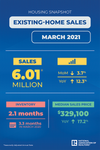FROM THE DESK OF THE CEO: A Legacy of Transformation and Warmest Wishes
I leave HGAR knowing that we are now more member-centric and innovative than ever before.

WASHINGTON—Existing-home sales fell in March, marking two consecutive months of declines, according to the National Association of Realtors. The month of March saw record-high home prices and gains. While each of the four major U.S. regions experienced month-over-month drops, all four areas posted year-over-year gains in home sales.
The median existing-home sales price in March rose by a record-breaking annual pace of 17.2% to a historic high of $329,100, with all regions posting double-digit price gains. The median existing-single-family home sales price jumped 18.4% to $334,500, both historic highs. March’s national price jump marks 109 straight months of year-over-year gains.
Total existing-home sales, completed transactions that include single-family homes, townhomes, condominiums and co-ops, decreased 3.7% from February to a seasonally-adjusted annual rate of 6.01 million in March. Sales overall climbed year-over-year, up 12.3% from a year ago (5.35 million in March 2020).
Existing-home sales in the Northeast slipped 1.3% in March, recording an annual rate of 760,000, a 16.9% jump from a year ago. The median price in the Northeast was $364,800, up 21.4% from March 2020.
“Consumers are facing much higher home prices, rising mortgage rates, and falling affordability, however, buyers are still actively in the market,” said Lawrence Yun, NAR’s chief economist. “The sales for March would have been measurably higher, had there been more inventory,” he added. “Days-on-market are swift, multiple offers are prevalent, and buyer confidence is rising.”
Yun said although mortgage rates have risen a tick, they are still at a favorable level and the economic outlook is promising.
“At least half of the adult population has received a COVID-19 vaccination, according to reports, and recent housing starts and job creation data show encouraging dynamics of more supply and strong demand in the housing sector,” Yun said.
Realtor.com’s Market Hotness Index, measuring time-on-the-market data and listing views per property, revealed that the hottest metro areas in March were Manchester, NH; Concord, NH; Vallejo, CA; Burlington, NC and Springfield, OH.
According to Freddie Mac, the average commitment rate for a 30-year, conventional, fixed-rate mortgage was 3.08% in March, up from 2.81% in February. The average commitment rate across all of 2020 was 3.11%.
Total housing inventory at the end of March amounted to 1.07 million units, up 3.9% from February’s inventory and down 28.2% from one year ago (1.49 million). Unsold inventory sits at a 2.1-month supply at the current sales pace, marginally up from February’s 2.0-month supply and down from the 3.3-month supply recorded in March 2020. Inventory numbers continue to represent near-historic lows; NAR first began tracking the single-family home supply in 1982.
“Without an increase in supply, the society wealth division will widen with homeowners enjoying sizable equity gains while renters will struggle to become homeowners,” Yun said.
Properties typically remained on the market for 18 days in March, down from 20 days in February and from 29 days in March 2020. Eighty-three percent of the homes sold in March 2021 were on the market for less than a month.
First-time buyers were responsible for 32% of sales in March, up from 31% in February and down from 34% in March 2020. NAR’s 2020 Profile of Home Buyers and Sellers—released in late 2020—revealed that the annual share of first-time buyers was 31%.
Individual investors or second-home buyers, who account for many cash sales, purchased 15% of homes in March, down from 17% in February and up from 13% in March 2020. All-cash sales accounted for 23% of transactions in March, up from both 22% in February and from 19% in March 2020.
Distressed sales—foreclosures and short sales—represented less than 1% of sales in March, equal to February’s percentage but down from 3% in March 2020.
Single-Family and Condo/Co-op Sales
Single-family home sales decreased to a seasonally-adjusted annual rate of 5.30 million in March, down 4.3% from 5.54 million in February, and up 10.4% from one year ago. The median existing single-family home price was $334,500 in March, up 18.4% from March 2020.
Existing condominium and co-op sales were recorded at a seasonally-adjusted annual rate of 710,000 units in March, up 1.4% from February and up 29.1% from one year ago. The median existing condo price was $289,000 in March, an increase of 9.6% from a year ago.
“NAR has made it a priority to be at the forefront of the anticipated economic revival,” said NAR President Charlie Oppler, a Realtor from Franklin Lakes, NJ and the CEO of Prominent Properties Sotheby’s International Realty. “We will continue pushing for an increase in housing construction and inventory, with the goal of helping qualified buyers and countless families achieve the American Dream of homeownership.”
Regional Breakdown
Existing-home sales in the Midwest declined 2.3% to an annual rate of 1,280,000 in March, a 0.8% rise from a year ago. The median price in the Midwest was $248,200, a 13.5% increase from March 2020.
Existing-home sales in the South dropped 2.9%, recording an annual rate of 2,700,000 in March, up 15.9% from the same time one year ago. The median price in the South was $283,900, a 15.6% climb from a year ago.
Existing-home sales in the West fell 8.0% from the month prior, posting an annual rate of 1,270,000 in March, a 15.5% rise from a year ago. The median price in the West was $493,300, up 16.8% from March 2020.
Receive original business news about real estate and the REALTORS® who serve the lower Hudson Valley, delivered straight to your inbox. No credit card required.